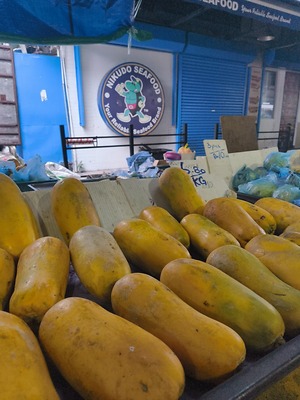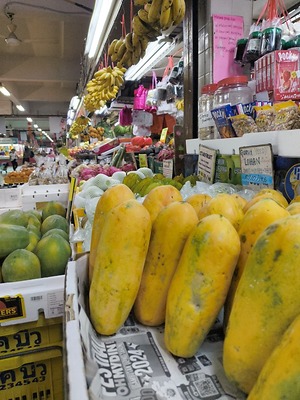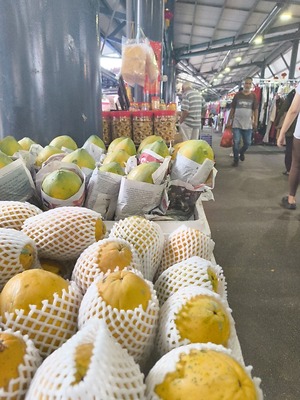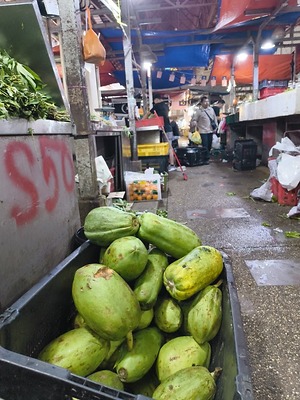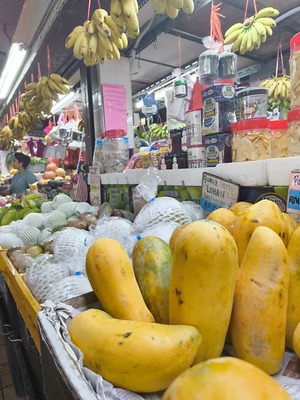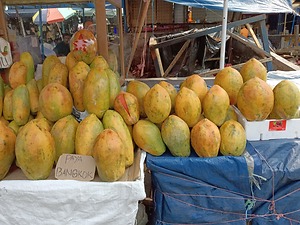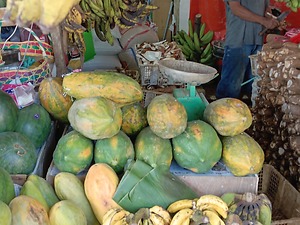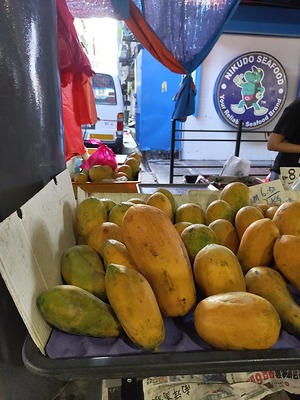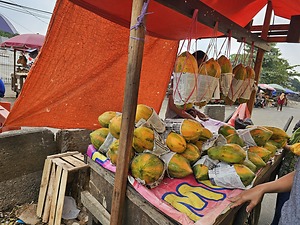


Bangkok Papayas
Estimated Inventory, lb : 0
Description/Taste
Bangkok papayas vary in size, depending on the specific variety and cultivation methods. The fruits generally have an elongated, cylindrical, or pyriform shape with tapered or blunt ends and a curved middle. The skin is thin, taut, smooth, and matte with a waxy feel, and transitions in color from green to golden yellow, yellow-green, to yellow-red hues. Underneath the surface, Bangkok papayas showcase red-orange flesh when ripe, with a central cavity filled with small, hard, black, round to oval seeds. When eaten young, the flesh is firm, dense, lightly aqueous, and crunchy, with a crisp, almost carrot-like consistency. If consumed in its mature state, it will become soft, aqueous, and succulent. Select Bangkok papayas that feel heavy for their size and give slightly when pressed. Ripe fruits are aromatic with a rich, sweet, tropical, floral, and musky flavor.
Seasons/Availability
Bangkok papayas are available year-round.
Current Facts
Bangkok papayas, botanically classified as Carica papaya, are a category of multiple varieties belonging to the Caricaceae family. The term Bangkok papaya is specifically used as a general descriptor for papaya cultivars grown in Thailand. Bangkok is the country’s capital city and is a well-known location internationally. It is important to note that this name is primarily used in international markets outside of Thailand, and popular Thai varieties like Khaek Dam, Khaek Nuan, Pluk Mai Lai, KU Gold, and Sai-Nampueng may be sold under this moniker. Papayas are a common fruit in Thai fresh markets and are seen in various stages of maturity for different culinary uses. The species is also a prevalent home garden tree, as multiple portions of the tree, including the fruit, leaves, flowers, and roots, have been traditionally used in medicinal and culinary preparations. Bangkok papayas are known for their versatility and are sought by chefs and consumers for their tropical, musky, and savory-sweet taste.
Nutritional Value
Bangkok papayas vary in vitamin and mineral content, depending on the specific variety. In general, papayas are a source of vitamins A, B, C, and E to guard the cells against free radical damage, strengthen the immune system, contribute to energy production in the body, and maintain healthy organs. Papayas also provide fiber to regulate the digestive tract and minerals like potassium, folate, magnesium, calcium, and phosphorus. Potassium balances fluid levels within the body, folate assists in producing genetic material, magnesium helps to control nerve functions, and calcium and phosphorus support bone and teeth health. In Thailand, ripe papayas are eaten after dinner as a natural digestive aid. The fruits are believed to have cleansing properties. The leaves are also occasionally used in natural remedies, pounded with other ingredients, and spread topically over irritations and swollen areas.
Applications
Bangkok papayas are consumed at multiple maturity stages and are suited for fresh and cooked preparations. When green and unripe, Bangkok papayas are diced into salads, added to curries and soups, or boiled with meat as a natural tenderizer. Bangkok papayas are also thinly cut or shredded and tossed in salt, chili powder, or other seasonings as a crunchy, refreshing dish. In addition to their green state, ripe papayas are softer in texture and are eaten in fruit bowls and salads. The flesh is also consumed as a healthy snack or blended into smoothies and shakes. Throughout Thailand, papayas are commonly simmered into jams or used as flavoring for baked goods. They are also pickled or dried for extended use. Beyond the flesh, the black seeds are edible and have a peppery taste. The seeds are utilized as a spice by drying and grinding them into a powder. This powder is sprinkled over dishes for enhanced flavoring. The leaves are also occasionally used as a cooked green, to tenderize meat, or steeped into tea. Bangkok papayas pair well with herbs like Thai basil, coriander, and lemongrass, spices including turmeric, cumin, ginger, and cinnamon, and other fruits such as coconut, mango, and bananas. Whole, unopened papayas should be kept at room temperature until ripe. Once ripe, they can be stored in the refrigerator for up to one week. Sliced papayas will keep for 2 to 3 days in a sealed container in the fridge. Cubed pieces can also be frozen for several weeks.
Ethnic/Cultural Info
Thai cuisine is customarily a communal experience shared between families and friends in Thailand. It is common for several dishes to be served and split, mainly consisting of a protein, a fresh salad or vegetable, and a carbohydrate like rice or noodles. Chilled, raw salads often include papayas in their yellow-green state for added flavor and crunch. On warm days, the salad keeps the body cool through sweat-inducing chiles and fresh ingredients. The most famous papaya dish prepared in Thailand is som tam, also called som tum. The shredded salad appears in many regional variations and has evolved from a Laotian dish called tam mak hoong. Early versions of the Thai salad were thought to have appeared in the late 18th to early 19th centuries. The Laotian dish is made from spicy, tangy, and salty ingredients, while Thai versions have added sweet, bright, and refreshing elements. Som tam is an everyday dish valued for its fiber, vitamins, and mineral content. It is also a popular street food widely sold throughout Thailand.
Geography/History
Papayas are native to the Americas and have been growing wild since ancient times. The center of origin is thought to have been in the lowlands of Eastern Central America, spanning from Mexico to Panama. Over time, multiple species were hypothesized to have been hybridized, and indigenous populations in Mesoamerica first domesticated the species. Seeds of the species could be stored for several years once dried, and these seeds were eventually carried from the Americas to the Caribbean, Europe, and Southeast Asia by Spanish and Portuguese explorers around the 16th century. Papayas were thought to have been introduced to Thailand sometime during the Middle Ayutthaya Period in the 16th to 17th centuries. Since their arrival in Thailand, papayas have been bred through cultivation for centuries for improved selections. Today, papayas are widely found in home gardens and on commercial farms. The fruits are sold domestically throughout Thailand in fresh markets and are also exported to other countries worldwide.



